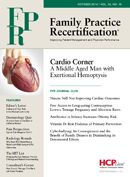Publication
Article
Family Practice Recertification
Opioid Risk Mitigation- Part 3
Author(s):
The third part in a series looking at the risk associated with the prescribing of opioid medications.

Michael E. Schatman PhD, CPE
In last month’s Pain Perspectives, we examined some of the measures that predict aberrant opioid-related behavior that can be effectively and efficiently utilized within primary care pain management practice. However, this represents only one of the initial steps toward safe prescribing to the carefully selected subpopulation of patients with chronic pain who can benefit from ongoing opioid therapy.
In this column, I will discuss opioid agreements and their potential to make your jobs as pain managers easier and safer — for both you and your patients. Also known as “opioid contracts”, the term “opioid agreement” is considered the more appropriate term at this time (1). Initially identified as “medication contracts” (2), these agreements have evolved over the years to capture the responsibilities of the patient treated with opioids – and, ideally, those of the prescribing physician.
Considered an aspect of “universal precaution” (3), a well-written opioid agreement can serve not only to protect the patient and the prescribing physician, but also may help build trust — thereby strengthening the patient-physician relationship. Unfortunately, too many opioid agreements are written in a unilateral fashion, emphasizing patient responsibility while ignoring that of the physician.
Full of “thou shalts” and “thou shalt nots”, unilateral agreements can have a deleterious effect on the patient-physician relationship — causing alienation and mistrust of the physician by patients (1). Accordingly, these agreements should be written with forethought and be sensitive to the emotional needs as well as the physical safety of our patients.
What are the features of a well-written opioid agreement? According to Arnold and colleagues (4), an agreement should: “1) emphasize that opiates are part of a comprehensive pain treatment program; 2) stress physician’s responsibility to work with the patient to improve their pain symptoms; 3) state that the purpose of the contract is to promote communication, clarify frequent issues that may arise in treatment, and prevent misunderstanding; 4) specify illicit behaviors that the literature suggests are red flags for opiate abuse (e.g., losing medicines, getting medicines from other providers); and 5) describe the possible physician behaviors that may occur if the patient engages in red-flag behaviors.”
While these recommendations are sound ones, it is important that each opioid agreement be written to meet the needs and beliefs of the individual physician as well as their patient population. Additionally, as our understanding of opioids and the interface of pain and addiction increases, the content of our opioid agreements will need to evolve.
For example, given our progressively increasing understanding of issues such as opioid-induced hyperalgesia and endocrinopathy, addressing these issues in our opioid agreements should be strongly considered. Similarly, the role of urine drug testing is becoming more widely accepted in pain medicine, and should certainly be referenced in all agreements (5).
How does one begin to write an opioid agreement? While each physician may wish to personalize the one that he or she uses, we do not need to reinvent the wheel. Having read hundreds of sample opioid agreements available online, I do not believe that any is sufficiently focused on risks associated with long-term opioid use. However, the agreement developed by Dr. Howard Heit, one of the originators of “universal precautions”, is relatively comprehensive. It can be accessed at no cost through Emerging Solutions in Pain at http://www.emergingsolutionsinpain.com/images/toolkit/practice/agreement/sample_opioid_agreement.pdf.
Good luck in developing your opioid agreements! In next month’s column, we will begin to investigate the imperative of sound urine drug testing practices as a critical element of the primary care pain management puzzle.
REFERENCES
1) Payne R, Anderson E, Arnold R, et al. A rose by any other name: pain contracts/agreements. Am J Bioeth. 2010;10:5-12.
2) Simons RD, Morris JL, Frank HA, et al. Pain medication contracts for problem patients. Psychosomatics 1979;20:118,123,127.
3) Gourlay DL, Heit HA, Almahrezi A. Universal precautions in pain medicine: A rational approach to the treatment of chronic pain. Pain Med. 2005;6:107-112.
4) Arnold RM, Han PK, Seltzer D. Am J Med. 2006;119:292-296.
5) Starrels JL, Becker WC, Weiner MG, et al. Low use of opioid risk reduction strategies in primary care even for high risk patients with chronic pain. J Gen Intern Med. 2011;26:958-964.
About the Author
Michael E. Schatman, PhD, CPE, is a clinical psychologist who has spent the past 27 years working in pain management. He is currently the Executive Director of the Foundation for Ethics in Pain Care in Bellevue, WA, where he also maintains a part-time practice in pain psychology. Schatman is the author of more than 80 peer-reviewed and invited journal articles and book chapters on pain management, and he lectures regularly on both local and national bases. He is the editor of Ethical Issues in Chronic Pain Management and Chronic Pain Management: Guidelines for Multidisciplinary Program Development, both of which were released in 2007. Currently, he is Editor-in-Chief of the Journal of Pain Research, Ethics Section Head Editor of Pain Medicine and Psychological Injury & Law, and Deputy Editor-in-Chief of the International Journal of Cannabinoid Medicine. Schatman serves on the Board of Directors of the American Society of Pain Educators, which named him 2011 Clinical Pain Educator of the Year.






